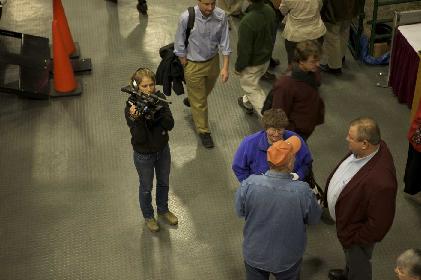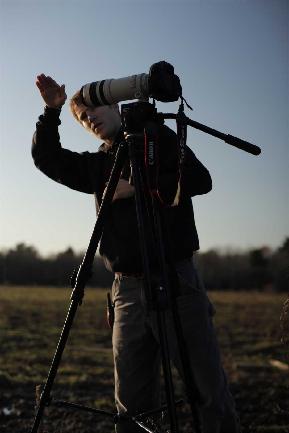
Collaborators Jason Mann and Cecily Pingree are learning all about the struggles of organic farmers working together on a new business venture in an uncertain economic climate in their film BETTING THE FARM.
LEF Program Manager Sara Archambault touched base with them to hear about what they’re learning along the way.
Sara: You are shooting BETTING THE FARM at a time when a number of films are coming out exploring our relationship to food. Your film is unique in that it looks closely at farmers as small business owners and entrepreneurs. Can you talk about why you chose to focus on that experience?
Cecily: There have been a number of excellent films about food and food policy in the last several years, and we’ve learned that audiences really respond to these issues. They are vital human concerns, and they resonate across geographical, socioeconomic and cultural boundaries.But we never set out to make a movie about the larger political and environmental issues at all. We stumbled on this story when we met one of the MOO Milk farmers, Aaron Bell of Tide Mill Organic Farm, while shooting another project. From the very beginning, we were interested in this story because of the people involved. Character-driven stories are what we like to watch, and what we get excited about, so it feels natural to us to focus on the lives of these farmers and their families rather than, say, the complexities of dairy pricing. That said, hopefully someone else will make that film!
Sara: Building this business has been a very challenging and risky time in the lives of your subjects. It’s amazing they’ve agreed to let this experiment be documented. Tell me about your relationship with them. How did you establish trust?

Jason: We’re grateful every time we shoot that our characters have agreed to let us be a part of their lives. It really is a collaborative relationship. We have to be able to trust our subjects that they will allow us access to their lives at very trying—sometimes painful—times, or we wouldn’t have a very exciting film. But in order to allow us that access, they need to be able to trust that we will not distort their words or reduce the serious, complicated problems they face into something false.Unfortunately, there is no formula for establishing trust with a film subject. In fact, it’s very much like establishing a “real life” relationship with someone: You have to spend time with that person and take it one day at a time. In our case, Aaron Bell was welcoming from the very beginning, probably because that’s just his nature, and because he’s been interviewed enough that he’s pretty comfortable with the idea of being “documented”. Once we met Aaron, he introduced us to Bill (Eldridge, MOO Milk’s CEO), who was happy to talk to us and be followed around. That helped us meet our other characters, because we were introduced to them as trustworthy (albeit curious) people. We didn’t just wander up to northern Maine and start banging on doors.Some people have expressed great surprise to us that the company would allow its most private, sensitive moments to be filmed. Other people in the business world (especially lawyers) seem a bit shocked that a company would take what must seem like an unnecessary risk of being embarrassed or otherwise hurt by a couple of nobodies with a video camera. But we think that fear is misplaced, and we are extremely grateful that the farmers and the management of MOO have been so open with us. With only a couple of exceptions, we’ve been allowed to film pretty much everything about this company, from the individual farmers in their homes to heated discussions of money at board meetings. In doing so, we think we’re showing a side of small business in America that is not at all well known. Because of the natural inclination toward secrecy and privacy in business, very few people have any sense of the real psychological and emotional struggles that go into getting a new enterprise off the ground. Certainly some other films like STARTUP.COM have touched on this, but I think it’s still a type of human drama that is under-represented.
Sara: How did you translate your original idea for this story into a visual strategy for the film?
Cecily: A lot of that happens naturally as you start to shoot. At least it does for us. We’re both big fans of verité films like Harlan County USA—a film that really gives the viewer a feel for the day-to-day grind of a community of coal workers. We think a key to achieving that (and if we do it half as well as Barbara Kopple did, we’ll be very happy) is to just spend time with your characters. Not all of the people you follow will be comfortable on camera, and the vast majority of what you shoot will wind up on the cutting room floor. But you need to spend time with them, befriend them, be with them, and eventually, if you’re lucky, the footage will start to show them going about their lives in a way that’s natural. It’s not that they’ve forgotten you’re in the room with a camera. It’s that they’re comfortable with having you there. If your subjects don’t trust you, you won’t get much useful footage. We knew from the outset that the MOO farmers lived in disparate parts of Maine, and that their lives would look very different. It was important to capture that visually. Most people who haven’t been to Maine think of rocky coasts, lighthouses and lobster boats. And if you’re in eastern Maine, that’s pretty much true. But northern Maine has an almost midwestern feel to it; separated from most of the rest of the state by miles of highway and forest, it’s pure farm country. It is really important to us that our scenic footage act as more than wallpaper. Where our characters live is inextricable from who they are.We are shooting the film on a Sony EX-1r. It’s a good combination of powerful and portable, for the many situations in which one of us is trying to cram into a tractor cab or a pickup to follow a character. We don’t have a lot of hard and fast rules for shooting. We go handheld a lot, but use sticks when we can. We light things occasionally, but usually try to find interesting things that natural light is already doing and place the frame accordingly. Buying a mixer and having one person on sound as much as possible was, aside from removing the lens cap, the single best technical decision we’ve made.One good piece of advice we heard recently on a completely unrelated project was “If something isn’t working, STOP DOING IT.” It’s surprising how easy it is to forget that when you’re engaged in a long project. But we try to evaluate how we’re shooting as often as possible, and to be constantly improving.
Sara: What kind of unexpected decisions have you had to make with the project so far? What have they taught you?
Jason: The simplest, most common unexpected decision: We kept deciding to shoot more. We knew going in that this would be a lengthy process to follow, but even so we were constantly surprised. The milk company itself has had a real roller coaster ride for the last year and a half, with each success followed closely by a potential calamity.
We also had to follow more characters and story lines than we ever could have predicted, simply because it was so unclear what would become of the company and our main characters. We’ve followed three farmers and their families, but what about the milk truck driver, who is dependent on income from the company and without whom none of the farmers could sell their milk? What about the major dairy that is an ally to the company, but also a potential threat? What about the complicated personalities of the potential lenders and investors in the company? We had to follow them all to some extent, just to make sure we weren’t missing some vital aspect of the story. That additional shooting was a major investment of time and energy that neither of us expected.The biggest lesson we’ve learned from all that extra shooting is pretty simple really: There’s no other way to do it. Don’t plan on shooting only what you need. (Or, if you prefer, plan on shooting what you need, but fundraise and budget for three times that.) Real life is not predictable, even if the events are written on your calendar. Expect plans to change. Expect to have to decide, with no preparation, between two events that seem equally important. Go with your gut.
Sara: The NEW YORK TIMES recently approached you to share some footage with them from your film to supplement a piece they were running on MOO Milk. Can you tell me a little bit about that experience? Would you do it again?
Cecily: Working for a major media outlet is a trip. It was a great opportunity to help tell the MOO Milk story to a huge audience, which was good for us and even better for the company. And it was a fascinating experience to cut our footage in a way that we will never cut it. Because the Times has a pretty set formula for their web videos, we were doing a lot of things we don’t normally do: working from a tight script, using tons of narration, etc. And in some ways, seeing our footage used in that way was reassuring (‘Hey! That looks pretty good!’).
One lesson we took away from that experience, though, was to get everything in writing. If we had it to do over again, we would have asked for (and probably gotten) at least a mention of the film on the Times website, which would have been very nice for promotion, fundraising, and general outreach for Betting The Farm. But if you wait until after the fact to discuss that kind of credit, the answer is always going to be ‘No.’ In the future, we would use that rare opportunity for publicity to cast some light on the film itself, not just the subjects.
All in all though, we were very happy with our experience working with the reporters and editors at the Times.

